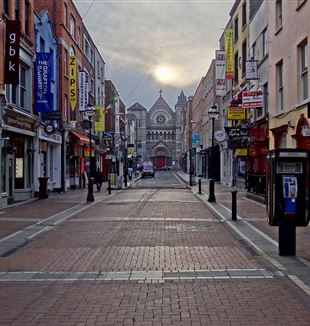
The Dubliners, The Wager
The vicissitudes of a group of friends in the Irish capital, beginning in the 1980s and still going strong, always in movement in a country in transformation.So much water has passed under Dublin’s Ha’ Penny Bridge since Mauro Biondi, a university student, landed on the shores of the Liffey River for the first time in 1980. A true Sicilian, he arrived in the city to continue his studies in Political Science and to respond to Fr. Giussani’s invitation, expressed in a 1982 card: “It would be beautiful if a seed of the Movement could be transplanted to Ireland, totally mingling with that land, bringing the clarity and passion for the faith that was there in olden times, and now is no longer.” Looking back, it’s heart-warming to see that things really did work out that way. During these twenty-seven years, Mauro got married and started a family, created a job for himself (the Emerald Cultural Institute), and got involved in a series of relationships that over time have consolidated into belonging to the Fraternity. “With the friends we’ve met here in Ireland,” says Mauro, “at a certain point, it was a natural and profoundly free transition to living the experience of the Movement in the form that this history had generated.”
Economic Development
Today’s Dublin differs greatly from the one that, years ago, baptized the newborn little Fraternity group. In the mid-1990s, the Emerald Isle surged into rollicking economic development that lifted it out of the poverty and unemployment that had condemned it to lag behind the other European nations. Driving the recovery were the multinationals like Microsoft, Hewlett-Packard, and Google that established themselves in the capital. “Our Fraternity group,” Mauro continues, “inevitably had to deal with this change. When we began, some of us were worried about work. I was the black sheep of the group, because I was an immigrant in search of work in a country with a very high emigration rate, with youth unemployment in some areas as high as 70%. Thanks to the help of friends in Italy, we were able to take a risk on an idea that sounded crazy to a lot of folks: an English school for foreigners.” Today, the Institute, with 170 employees, welcomes about 5,000 students a year from all over the world. “Among the friends of the Movement who work at the Emerald Institute,” explains Mauro, “we often say that sharing our workplace is a gift, because it gives us the chance to engage our friendship here, shaping it according to the ideal we’ve encountered.” This is possible if you start anew every morning, well equipped “with the desire of the heart,” Mauro continues.
As the economic boom has transformed the physiognomy of Ireland–in the last few years 100,000 Poles have arrived–so too the Fraternity group has changed. “We’ve met many newly arrived people, and gotten involved in their lives, in their problems with getting established. If there was the need, we welcomed them into our homes and offered them the possibility of a friendship, including through the experience of the Fraternity.”
A Profound Lack
The economic boom hasn’t been the only cyclone to hit the island–another, more menacing one, looms over the heads of those whose homeland was once one of the last bulwarks of Christianity. “In lockstep with the rebirth of the country,” explains Mauro, “there has been a progressive de-Christianization. The Fraternity is continually grappling with this profound change as well.” The first problem the friends of the Fraternity encountered was the educative void, the dearth of a clear Christian proposal in a society that previously had always provided it. One example is catechism. “Historically, the school has always been responsible for the Christian formation of the kids,” Mauro recounts. “The parishes don’t do the catechism; it’s part of the normal school syllabus. So, in second grade the children are prepared for their First Communion, and in sixth grade for Confirmation. The problem is that, today, you can’t take for granted that the teachers are still believers. The educative subject is missing. Often, young people are given only hypocritical rules for limiting alcohol abuse, which is very widespread among them, starting even with twelve-year-olds.” In this circumstance as well, the Fraternity has rolled up its shirt-sleeves, not out of mere activism, but simply for the good of their own children. And so the outlook of the group has generated the experience of the “Grail” kids, a swarm of exuberant 11- to 14-year-olds, led by two adults, who set aside their respective school uniforms after school and help each other study, organize outings, sing in the choir, and attend Mass together, involving other peers as well.
Thus, the borders of the group go well beyond its members. It’s a continual blurring together, mixing, and getting involved with the work of the whole Movement. “We’re subject to an incessant dynamism,” concludes Mauro, “that forces us to change constantly and prevents us from getting fossilized in our idea of what a Fraternity group should be.” Though they are too modest to say so, it’s precisely this friendship lived as openness and service that has launched a great public gesture in “pagan” Dublin: a very well-attended formal dinner organized at Christmas to raise funds for AVSI projects, and a Way of the Cross last Easter, followed by 1,500 people and led by Archbishop Martin. Hardly trifling signs of Christian renewal.